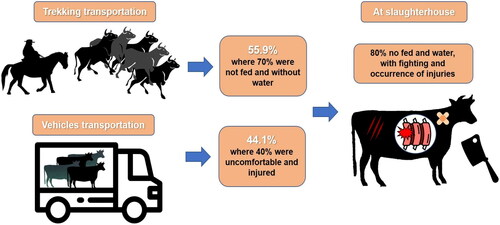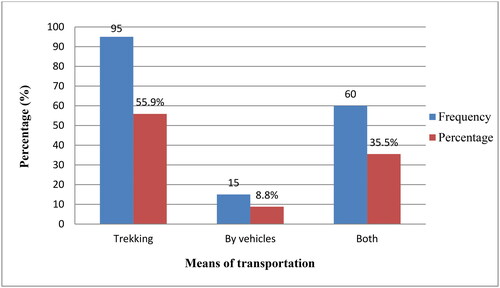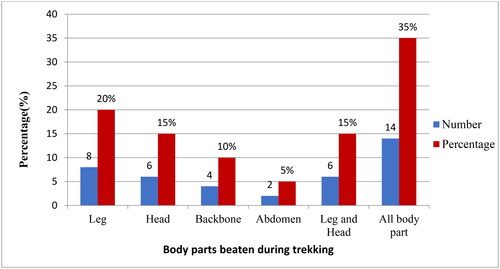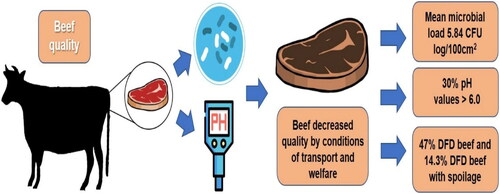 ?Mathematical formulae have been encoded as MathML and are displayed in this HTML version using MathJax in order to improve their display. Uncheck the box to turn MathJax off. This feature requires Javascript. Click on a formula to zoom.
?Mathematical formulae have been encoded as MathML and are displayed in this HTML version using MathJax in order to improve their display. Uncheck the box to turn MathJax off. This feature requires Javascript. Click on a formula to zoom.Abstract
During transport from farms to abattoirs, animals may be subjected to un-favorable conditions leading to a compromise of animal welfare and reduced meat quality. The impact of pre-slaughter handling and transportation on animal welfare and beef quality was investigated in relation to Dendi and Welmara districts markets and abattoirs. Semi-structured questionnaires were used to gather detailed information on the pre-, during-, and post-slaughter processes from 200 respondents. 70 meat swab samples were collected from desirable animal parts to determine the microbial load, and 100 beef samples were used to evaluate the pH value. The majority of animals (55.9%) were transported via trekking, with 70% not receiving feed or water during transportation. Approximately 47% of beef was classified as Dark, Firm, and Dry (DFD) and was spoiled with microbial growth. The pH value of the meat was significantly affected by the distance traveled during transportation and the mode of transportation (P = 0.001). The mean log of the bacterial count of the sampled meat was 5.84-CFU log/100cm2, with the mean microbial load being statistically different (P < 0.05). Our findings suggest that animal welfare and beef quality were compromised due to stressful transportation, pre- and post-slaughter procedures, lack of facilities in marketing areas, and a poor abattoir system. Therefore, it is vitally necessary to issue relevant declarations, and legislation, and provide training on animal welfare awareness to various stakeholders.
REVIEWING EDITOR:
1. Introduction
Animals can be harmed during the pre-slaughter phase when ethical standards or guidelines regarding animal welfare are not followed (Karabasil et al., Citation2019). The importance of considering not only the physiological needs of animals but also their natural and emotional behaviors and the environment in which they live is emphasized in the definition of animal welfare, which describes the condition of an animal in relation to its attempts to adapt to its environment (Broom, Citation1986; WOAH, Citation2019). Animal welfare can be promoted by proper handling and transport of cattle, which also has significant economic and efficiency advantages resulting in a higher quality post-slaughter product (BQA, 2011; Carrasco-García et al., Citation2020; Gadisa et al., Citation2019). However, inadequate handling and transport can cause animal stress, leading to physical injuries, food and water shortages, improper loading and unloading, and altered body conditions a few hours before slaughter (José-Pérez et al., Citation2022; Pinheiro et al., Citation2020; Rodríguez-González et al., Citation2022). Decreased meat quality and animal safety can result from these issues (Gebawo & Adem, Citation2019), ultimately affecting the profit of zootechnical exploitation (Mesfin et al., Citation2021). It is crucial to ensure that vehicles, transport facilities, and handling routes are appropriately designed to prevent problems of improper handling during transport as the emotional states of the animals can also be disturbed by handlers’ harsh treatments.
In some cases, mainly in low-income countries, long-distance transport of beef cattle from farms to terminal markets is common, but it is a stressful and cost-effective transport method that compromises animal welfare and meat quality (Anteneh & Negassi, Citation2017; Mesfin et al., Citation2021). Factors such as food and water deprivation, unfavourable ventilation, aggression, physical harm, hunger, thirst, heat stress, and pain contribute to this transportation method’s negative effects (Carrasco-García et al., Citation2020). Moreover, the transportation process until the slaughter moment involves complex factors that expose animals to stressors such as changes in temperature, air quality, vibration, and noise (Gadisa et al., Citation2019; Jones et al., Citation2010).
In most developing countries, particularly those with lower per capita income, animals often lack protection from suffering due to a lack of animal welfare regulations and legalized institutions (Antonia, Citation2013). Handlers occasionally inflict pain and injury on animals by hitting them, mainly because they view them as commodities rather than sentient beings capable of feeling pain and stress or due to a lack of knowledge about animals and their welfare (Broom & Fraser, Citation2007). Animal welfare is compromised for various reasons, including breeding procedures and resulting difficulties, ill-treatment, accidental neglect, lack of knowledge, and inadequate housing design, including pens. Additionally, inadequate management systems or poor husbandry at the producer’s level, poor conditions and procedures during moving or loading, transport, and at the market or slaughterhouse negatively impact the welfare of beef cattle (Aleme & Bekele, Citation2021; Bulitta et al., Citation2012; FAO, Citation2016). Frimpong et al. (Citation2014) reported that in Ghana, 16% of producers’ income was lost due to disease and injuries from farms to markets and abattoirs.
Dark-cutting meat is generally defined as meat with high ultimate pH (pHu). In many countries, carcasses with a pH threshold ≥6.0 in the loin are defined as dark-cutting (Gagaoua et al., Citation2021). Although many references refer to the main factor influencing the pHu being muscle glycogen content at slaughter, the inherent determinant is the concentration of hydrogen ions, which are predominantly generated through glycolysis and the formation of lactate from glycogen, but also from ATP hydrolysis, which is reviewed in several studies (Apaoblaza et al., Citation2020). There are several other aspects of dark-cutting meat that warrant attention including (i) time of grading, (ii) rate of pH and temperature decline and (iii) muscle type, which influences among others glycogen content.
The potential for meat production and marketing in these countries is significantly affected by the pre-slaughter handling and transportation of animals, which has a substantial impact on animal welfare and beef quality. Developing policies, strategies, and business development services for an efficient value chain in beef marketing requires a thorough understanding of the effects of handling and transport on animal welfare and beef production.
To achieve this goal, a study was initiated to investigate the impacts of handling and transport on animal safety and meat quality. The study aims to gain insight into the effects of handling and transportation, which will inform future development strategies and improve the efficiency of the beef value chain for low-income countries.
2. Materials and methods
2.1. Description of the study areas
This study was conducted in central Ethiopia, specifically in Dendi and Welmara districts. Dendi is located 78 km from Addis Ababa in the West and has an altitude ranging from 1600 to 3268 m a.s.l. There are about 20,762 households in the district, and the total number of cattle found in Dendi was estimated to be 234,122 (DDLFRDO, Citation2019). There are about 83,784 households in Welmara district, and the total cattle population was estimated to be 191,438 (WSZLFRDO,Citation2019). The mean annual temperature of the study region ranged from 9.3-23.8 °C. It receives 500–1172 mm of annual rainfall. Welmara Special Zone of Oromia is located 32 km from the capital city of Addis Ababa in the West. This zone ranges from 2000 to 3380 m.a.s.l. and has a mean annual temperature of 12.3-15.9 °C. The annual rainfall of the special zone ranges from 1000 to 2200 mm.
2.2. Study design and sampling techniques
A cross-sectional study design was used from September 2022 to June 2023. Field questionnaire survey and laboratory analysis were conducted as a study tool. Dendi and Welmara districts were purposively selected based on potential and accessibility in beef cattle production and marketing in Shewa Zone. Cattle brought to the market and bought for slaughter purpose were selected by simple random sampling technique after they were bought and isolated from the rest animal. The stakeholders in this study were similarly chosen using a simple random sampling approach.
2.3. Questionnaire survey
A semi-structured questionnaire was used to collect data from different target groups involved in which include beef cattle producers, beef cattle traders, abattoir workers and butcher. The respondents were selected based on a preliminary survey and randomly in proportion to the number of household stakeholders. Accordingly, a total of 200 stakeholders; comprising of beef cattle producers/farmers (70), traders/transporter (40), cattle trekkers (40), butchers (20), and abattoir workers (30) were included in this study. The survey focused on assessing how far the cattle were transported by trekking or by vehicles, whether or not beef cattle were allowed to take feed, water and rest during trekking, whether or not animals were beaten during transportation using trekking and during loading and unloading in vehicles transportation. Besides, management conditions in the lairage were assessed concerning animal welfare and beef quality.
2.4. Laboratory analysis
The Dendi municipal abattoir and the Welmara municipal abattoir each have a monthly slaughtering capacity of 500 cattle (250 each). In accordance with this data, 1122 beef cattle were slaughtered during a two-month period, with 10% being considered the sample size. Accordingly, 100 beef samples of a small proportion of meat (50 from each abattoir) were collected from the left longissimus thoracis (LT) at the level of the 10th ribs to determine pH values. In addition, 70 beef swab (35 from each abattoir) samples were collected from the flank, brisket, and rump of cattle slaughtered in the abattoirs for the analysis of aerobic bacterial load. For sensory evaluation, the whole carcass of the slaughtered beef cattle was observed, palpated, and smelled by keeping strictly to the hygienic condition of the meat while wearing surgical gloves and aprons. Meat samples were collected immediately after animal slaughter by using sterile gloves and kept in sterile polyethylene bags. Analysis of the microbial load was undertaken in the microbiology laboratory of Ambo University. Measurements of pH and visual inspections were conducted in Dendi and Welmara’s municipal abattoirs.
2.4.1. Sensory and meat quality evaluation
To assess the quality of beef, we conducted organoleptic tests on the whole carcass of the slaughtered beef cattle, which included evaluating the meat’s smell, sight, and touch (FAO, Citation2020). Additionally, we used a calibrated digital pH meter (MP511, China) to measure the pH value of the Longissimus-Dorsi muscle, located at the level of the 12th ribs, approximately 24 hours after slaughter, following standard procedures. According to Gunter and Hautzinger (Citation2007), normal meat has a pH range of 5.4–6, while DFD meat has a pH value above 6.
2.4.2. Determination of aerobic bacterial load
The bacterial load from swab samples was determined using the Aerobic Plate Count (APC) method, following the swab method recommended by Adzitey, (Citation2011). Purposively collected from the carcass in the abattoir (57.1%) and butcher shops (42.9%), a total of 70 meat swab samples (10cm × 10cm) were obtained. Sterile plastic bags were used to collect the samples during twenty successive visits. They were immediately transported under 4 °C in an icebox filled with ice packs to the laboratory for analysis. The colony-forming unit per centimeter square (CFU/cm2) was determined by counting plates of consecutive dilutions containing 30-300 colonies after incubation, according to FSSAI (Food Safety & Standards Authority of India) (Citation2012) guidelines.
Where ΣC is the sum of colonies counted on all the dishes retained, N1 is the number of dishes retained in the first dilution, N2 in the second dilution, and D is the dilution factor corresponding to the first dilution. If a bacterial load count equals 107-108, meat spoilage is apparent (Teye & Okutu, Citation2009).
2.5. Data management and analysis
The collected data was entered, filtered, coded, checked for data distribution and extreme value using Microsoft Excel spreadsheet and analyzed by using Statistical Package for Social Science (SPSS) software version 20. Qualitative data collected through the description, explanation, narration, and personal observation were scrutinized. Descriptive statistics such as percentage, mean, and standard deviation and inferential statistics like independent t-tests, and one-way ANOVA was used for data analysis. Results were considered significant when P < 0.05. Correlation co-efficient for PH, microbial load, sensory evaluation, age and distance travelled were done to measure the relationship between variables of interest.
3. Results and discussion
3.1 Effect of trekking on the welfare of beef cattle
The primary means of transporting beef cattle in the study area was trekking, according to 55.9% of respondents, with 35.3% reporting using both trekking and vehicles and only 8.82% using vehicles alone ( and ). A statistically significant difference (P < 0.01) was observed between the means of transportation. Trekking was also found to be the most common method of transporting beef cattle in other studies conducted in Ethiopia by Bulitta (Citation2012) and Fufa (Citation2015).
Figure 1. Impacts of means transportation on animal welfare, highlighting abrasion injury observed at slaughterhouse.

Figure 2. Means of cattle transportation to slaughterhouse in the study areas, according to our survey.

The study found that beef cattle travelled long distances median 47 ± 42.0 km to the Dendi market within median estimated travel time of 14.5 ± 13.8 hours and 70 ± 57.5 km to the Welmara market within median estimated travel time of 18 ± 26.8 hours (). During transport, the animals were exposed to harmful environmental conditions (Gupta et al., Citation2023), such as high temperatures, heavy rainfall, and severe cold. The findings are consistent with previous studies conducted by Saeid et al. (Citation2016), Geleta and Diribe, (Citation2020), and Mesfin et al. (Citation2021), which suggest that the means of transportation and transport time can have an impact on animal production and health.
Table 1. Estimated distance (km) travelled by beef cattle to reach Dendi and Welmara animal markets.
The study also found that beef cattle were not provided with rest, feed, or water during trekking from the local market to secondary markets. Only 80% of farmers provided feed and water for beef cattle during trekking from farms to primary markets ().
Table 2. Beef cattle handling with regard to feed and water provision by cattle trekkers and producers.
All respondents (100%) reported that the animals were frequently beaten during trekking, primarily on all body parts (35%), followed by legs (20%) and legs and head (15%) (). Improper cattle handling in this study may be due to a lack of education and poor awareness among animal handlers regarding pre- and post-slaughtering effects on meat quality and animal welfare. The results are consistent with FAWC (Farm Animal Welfare Council) (Citation2013) and Njisane and Muchenje (Citation2017), who report that insufficient feed and water during transport and the use of overcrowded vehicles can lead to impaired meat hygiene and animal welfare.
3.2 Effect of vehicle transportation on the welfare of beef cattle
Various factors affect the quality of animal transportation by vehicle, including vehicle type, transport distance, driver’s skill, route conditions, and weather. In the study area, inadequate vehicles were used to transport cattle, leading to limb fractures, skin bruises, and panic among placid animals during loading and unloading on steep roadsides. The use of aggressive tactics, such as repeatedly beating animals, was common to overcome their resistance to loading and unloading. About 40% of traders reported overloading Isuzu trucks with 12-17 beef cattle beyond its carrying capacity, leading to overcrowding and compromising animal welfare and meat quality. This result is in accordance with previous studies Bulitta (Citation2012), Fufa (Citation2015), and Chulayo and Muchenje (Citation2017).
The reluctance of all beef cattle to enter the truck resulted in handlers using forceful tactics, such as horn-dragging and stick-beating, to compel them to move. As a result, the animals experienced high-stress levels, which negatively impacted their welfare and meat quality ().
Table 3. Estimated numbers of beef cattle handling for comfort during vehicle transportation.
3.3. Effect of lairage conditions on the welfare of cattle
Inappropriate lairage conditions can negatively affect carcass and meat quality. Restraining the movement of cattle, hitting or grabbing them by the coat, and exposing them to microbial contamination are examples of inappropriate lairage conditions (). Therefore, providing suitable lairage conditions is crucial to prevent infections and minimise stress. Unfortunately, none of the respondents reported providing adequate rest and feed to animals in the lairage. 80% of them indicated that beef cattle were not receiving proper rest and feed, and fighting between animals was a common occurrence. These findings align with Gregory et al. (Citation2010) research, which demonstrated that stress before or during slaughter could negatively impact cattle welfare and meat quality at the abattoir. Proper removal and disposal systems for lairage manure and waste, as well as effective sanitation facilities and drainage systems, are essential in any abattoir.
Table 4. Beef cattle handling during lairage.
3.4. Effects of transportation distance and means of transportation on beef quality
More than half (54.3%) of the beef samples were classified as normal, with pH values ranging from 5.4 to 6, while 45.7% were considered abnormal, according to the pH values obtained. Dark, Firm and Dry (DFD) beef (15.7%) and DFD beef with spoilage (14.3%) resulted from pH values greater than 6.0, which were found in 30% of the beef samples (). A higher ultimate beef pH (above 6.0) may result from increased physiological stress or physical activity in cattle during pre-slaughter handling, which depletes muscle glycogen reserves (Ekiz et al., Citation2012; Muchenje et al., Citation2009). Gebawo and Adem (Citation2019) and Mesfin et al. (Citation2021) support this finding.
Table 5. Effects of means of transport and distance (km) on beef quality parameters.
It was found through sensory evaluation that more than half (53.3%) of the beef samples were considered normal, while the rest (46.7%) were considered abnormal. The study found that the transportation of beef cattle over 60 km using vehicles had the highest percentage of abnormal beef (47%), from which 14.3% was DFD with spoilage while 11.4% () was spoiled microbial beef. A very low pH level of meat is caused by a high level of acid produced after slaughtering, resulting in PSE meat (Adzitey, Citation2011). Mesfin et al. (Citation2021) reported that long-distance transportation, improper handling, and poor management of animals in the large lairage resulted in DFD beef and DFD beef with spoilage.
The distance covered by beef cattle, whether using trekking or vehicle, significantly affected the pH (z = -3.235; P = 0.001), as shown by the independent sample test statistics comparison. The microbial load was higher in beef cattle transported by vehicle than by trekking (z = -2.601; P = 0.005), and the mean pH value of the sampled meat was 5.84 ().
Table 6. Comparison of independent sample z-test of the variable of the study.
The current result of the microbial load of sampled meat (5.84-CFU log/100cm2) agreed with the findings of Hassan et al. (Citation2010), who stated that meat is one of the most perishable foods, and its composition is ideal for the growth of a wide range of spoilage bacteria. Faulty and poor processing conditions may transfer both pathogenic and non-pathogenic organisms onto the meat from the gastrointestinal tract of cattle. Aleme and Bekele (Citation2021) reported that PSE and DFD have poor processing characteristics, reduced yield, and a high potential for spoilage compared to typical meat, corroborating this finding. The mean log of the bacterial count of sampled meat was 5.84-CFU log/100cm2 (). The results of the one-way ANOVA analysis indicated that the mean microbial load differed significantly (P < 0.05) between grades of meat (DFD, DFD with spoilage, normal, and PSE with spoilage).
The correlation analysis showed that meat from the cattle that were subjected to poor handling, microbial load increased as ultimate pH increased (a strong positive correlation, r = 0.266 (p-value= 0.026). In addition, PH and microbial load have been significantly correlated with meat sensory evaluation parameters (touch, smell and sight) (a strong positive correlation, r = 0.35(p-value = 0.003) and r = 0.241(p-value = 0.045) respectively. As PH and microbial load of the meat from the poorly handled cattle increased, meat sensory evaluation parameters were affected.
The mean aerobic plate count (APC) of swabs from the carcass was found to be lower than the findings of Kebede et al. (Citation2014), who reported an aerobic plate count of APC (6.24-CFU log/100cm2). Such differences could be attributed to pre-slaughter beef cattle handling, butcher shop contamination, slaughter process, carcass handling, and distribution and abattoir management practices.
4. Conclusion and recommendations
According to the current findings, cattle were transported to and from markets over long distances mainly using trekking, which exposed animals to stressful transportation and improper handling. Furthermore, cattle handling and management practices in the lairage had a negative impact on animal welfare and carcass quality. Poor handling of cattle prior to slaughter has led to a high incidence of DFD meat and microbial spoilage, which proves that poor handling of cattle immediately before slaughter had an effect on meat quality. Inadequate pre-slaughter conditions compromised carcass quality by increasing the susceptibility of cattle to bruising. In poorly-handled cattle, microbial load increased as ultimate pH increased. Therefore, government bodies responsible for livestock and fishery resource development, animal health, and the agricultural sector should collaborate to develop community-based interventions that prioritize the welfare of beef cattle and the quality of meat produced.
Author contributions
A.B. designed the study, advised methodology, collected data, T.T. advised methodology, conducted analysis, original draft. A.B. and T.T. provided editing and review of the manuscript. All authors contributed to the article and approved the submitted version.
Ethical considerations
The study protocol was reviewed by Ambo University Research and Ethical Committee. The nature of the study was fully explained to the study participants to obtain their oral informed consent before participation in the research, and the data was kept confidential.
Author Bio.docx
Download MS Word (12.4 KB)Disclosure statement
No potential conflict of interest was reported by the author(s).
Additional information
Notes on contributors

Amanuel Bekuma
Amanuel Bekuma is a lecturer and researcher in the Department of Animal Science at Mattu University. He holds a master of science in animal production. He also has five peer-reviewed journals. His research interests include animal husbandry, Poultry science, and meat science and technology.
Tekalign Tadesse
Tekalign Tadesse is a lecturer and researcher in the Department of Veterinary Science at Mattu University. He is an assistant professor of tropical and infectious diseases who currently has publications in peer-reviewed journals. His research interests include livestock health management, infectious diseases, zoonoses, and antimicrobial resistance.
References
- Adzitey, F. (2011). Effect of pre-slaughter animal handling on carcass and meat quality. International Food Research Journal, 18, 1–9.
- Aleme, M., & Bekele, G. (2021). Effect of handling cattle during transport and marketing on quality of beef. Journal of Fisheries Livestock Production, 9, 305.
- Anteneh, W., & Negassi, A. (2017). Review on effect of transportation and handling on meat quality and animal welfare of sheep in Ethiopia. Advances in Life Science and Technology, 53, 1–4.
- Antonia, G. (2013). Animal welfare in Ethiopia: Handling of cattle during transport and operations at Kera Abattoir, Addis Ababa [Doctoral dissertation, Swedish University of Agricultural Sciences].
- Apaoblaza, A., Gerrard, S. D., Matarneh, S. K., Wicks, J. C., Kirkpatrick, L., England, E. M., Scheffler, T. L., Duckett, S. K., Shi, H., Silva, S. L., Grant, A. L., & Gerrard, D. E. (2020). Muscle from grass- and grain-fed cattle differs energetically. Meat Science, 161, 107996. https://doi.org/10.1016/j.meatsci.2019.107996
- Beef Quality Assurance (BQA). (2016, May 20). National Beef Quality Audit. Retrieved May 20, 2016, from http://www.bqa.org/resources/ audits/2011-national-beef-quality-audit.
- Broom, D. M. (1986). Indicators of poor welfare. The British Veterinary Journal, 142(6), 524–526. https://doi.org/10.1016/0007-1935(86)90109-0
- Broom, D. M., & Fraser, A. F. (2007). Domestic animal behavior and welfare (4th ed., pp. 495–520). Cambridge University Press.
- Bulitta, F. S. (2012). Effect of handling on animal welfare during transport and marketing: The case of Gudar market and Ambo Abattoir, Ethiopia. Journal of Service Science and Management, 5(1), 59–68. https://doi.org/10.4236/jssm.2012.51008
- Bulitta, F., Gebresenbet, G., & Bosona, T. (2012). Animal handling during supply for marketing and operations at an abattoir in developing country: The case of Gudar market and Ambo Abattoir, Ethiopia. Journal of Service Science and Management, 5(1), 59–68. https://doi.org/10.4236/jssm.2012.51008
- Carrasco-García, A. A., Pardío-Sedas, G. G., León-Banda, C. A., Pedro Paredes, R., Bertha, C., Hernández-Cruz, V., & Vicente, V. M. (2020). Effect of stress during slaughter on carcass characteristics and meat quality in tropical beef cattle. Asian-Australasian Journal of Animal Sciences, 33(10), 1656–1665. https://doi.org/10.5713/ajas.19.0804
- Chulayo, A., & Muchenje, V. (2017). Activities of some stress enzymes as indicators of slaughter cattle welfare and their relationship with physico-chemical characteristics of beef. Animal: An International Journal of Animal Bioscience, 11(9), 1645–1652. https://doi.org/10.1017/S1751731117000222
- DDLFRDO, (Dendi District Livestock and FisheryReseource Development Office) (2019). District level annual Report, West Shewa, Ethiopia.
- Ekiz, B., Ekiz, E. E., Kocak, O., Yalcintan, H., & Yilmaz, A. (2012). Effect of pre-slaughter management regarding transportation and time in Lairage on certain stress parameters, carcass and meat quality characteristics in Kivircik. Meat Science, 90(4), 967–976. https://doi.org/10.1016/j.meatsci.2011.11.042
- FAO. (2016). Food and Agriculture Organization of the United Nations, statistical yearbook. Retrieved November 9, 2022, from https://www.fao.org/policy-support/tools-and-publications/resources-details/en/c/1458575/
- FAO. (2020). Meat and meat products, Animal production and health division. Retrieved November 20, 2022.
- FAWC (Farm Animal Welfare Council). (2013). Retrieved April 23, 2022, from http://www.defra.gov.uk/fawc/about/five-freedoms/
- Frimpong, S., Gebresenbet, G., Bobobee, E., Aklaku, E. D., & Hamdu, I. (2014). Effect of transportation and pre-slaughter handling on welfare and meat quality of cattle: A case study of Kumasi abattoir, Ghana. Veterinary Sciences, 1(3), 174–191. https://doi.org/10.3390/vetsci1030174
- FSSAI (Food Safety and Standards Authority of India). (2012). Manual of methods of analysis of foods. Microbiological testing Lab Manual (Vol. 14, pp. 3–4).
- Fufa, S. (2015). Effects of handling on animal welfare during transport and marketing [Doctoral dissertation, Swedish University of Agricultural Sciences].
- Gadisa, B., Yusuf, Y., & Kurtu, M. Y. (2019). Evaluation of physical facilities, operation and management practice in selective public abattoirs in Eastern Oromia, Ethiopia. International Journal of Agricultural Science and Food Technology, 5, 043–049. https://doi.org/10.17352/2455-815X.000040
- Gagaoua, M., Warner, R. D., Purslow, P., Ramanathan, R., Mullen, A. M., López-Pedrouso, M., Franco, D., Lorenzo, J. M., Tomasevic, I., Picard, B., Troy, D., & Terlouw, E. M. C. (2021). Dark-cutting beef: A brief review and an integromics meta-analysis at the proteome level to decipher the underlying pathways. Meat Science, 181, 108611. https://doi.org/10.1016/j.meatsci.2021.108611
- Gebawo, T., & Adem, H. (2019). Effect of pre-slaughter animal handling on the physico-chemical and microbiological quality of beef in selected municipal abattoirs, Oromia Regional State, Ethiopia. EC Veterinary Science, 4, 202–212.
- Geleta, G., & Diribe, K. (2020). Review on the effect of handling, slaughtering process and transport on welfare of animals and meat quality in Ethiopia. Animal and Veterinary Sciences, 8, 84–92.
- Gregory, N. G., Fielding, H. R., Von Wenzlawowicz, M., & Von Holleben, K. (2010). Time to collapse following slaughter without stunning in cattle. Meat Science, 85(1), 66–69. https://doi.org/10.1016/j.meatsci.2009.12.005
- Gunter, H. G., & Hautzinger, P. (2007). Meat processing technology for small-to medium-scale producers. Food and Agriculture Organization of the United Nations Regional Office for Asia and the Pacific, FAO, pp. 1–447. Retrieved November 5, 2022, from https://www.fao.org/3/ai407e/ai407e.pdf
- Gupta, D., Kashyap, G., Ashutosh, M., & Yadav, A. (2023). Effect of vitamin C, electrolyte, and jaggery on transportation stress in different seasons on biochemical parameters of goats. Applied Veterinary Research, 2(2), e2023008. https://doi.org/10.31893/avr.2023008
- Hassan, A. N., Farooqui, A., Khan, A., Khan, A. Y., & Kazmi, S. U. (2010). Microbial contamination of raw meat and its environment in retail shops in Karachi, Pakistan. The Journal of Infection in Developing Countries, 4(06), 382–388. https://doi.org/10.3855/jidc.599
- Jones, T. A., Waitt, C., & Dawkins, M. S. (2010). Sheep lose balance, slip and fall less when loosely packed in transit where they stand close to but not touching their neighbors. Applied Animal Behaviour Science, 123(1–2), 16–23. https://doi.org/10.1016/j.applanim.2009.12.006
- José-Pérez, N., Mota-Rojas, D., Ghezzi, M., Rosmini, M., Mora Medina, P., Bertoni, A., Rodríguez-González, D., Domínguez-Oliva, A., & Guerrero Legarreta, I. (2022). Effects of transport on water buffaloes (Bubalus bubalis): factors associated with the frequency of skin injuries and meat quality. Journal of Animal Behaviour and Biometeorology, 10(2), 1–9. https://doi.org/10.31893/jabb.22016
- Karabasil, N., Boskovic, T., Vicic, I., Cobanović, N., Dimitrijevic, M., & Teodorovic, V. (2019). Meat quality: Impact of various pre-slaughter conditions. IOP Conference Series: Earth and Environmental Science, 333(1), 012033. https://doi.org/10.1088/1755-1315/333/1/012033
- Kebede, H., Melaku, A., & Kebede, E. (2014). Constraints in animal health service delivery and sustainable improvement alternatives in North Gonder, Ethiopia. Journal of Cattle Sciences, 81, 10–24.
- Mesfin, D., Berhane, M., & Endrias, Z. (2021). Effect of pre-slaughter beef cattle handling on welfare and beef quality in Ambo and Guder markets and abattoirs, Oromia Regional State, Ethiopia. Ethiopian Journal of Science and Technology, 14, 89–104.
- Muchenje, V., Dzama, K., Chimonyo, M., Strydom, P. E., & Raats, J. G. (2009). Relationship between pre-slaughter stress responsiveness and beef quality in three cattle breeds. Meat Science, 81(4), 653–657. https://doi.org/10.1016/j.meatsci.2008.11.004
- Njisane, Y. Z., & Muchenje, V. (2017). Farm to abattoir conditions, animal factors and their subsequent effects on cattle behavioral responses and beef quality-A review. Asian-Australasian Journal of Animal Sciences, 30(6), 755–764. https://doi.org/10.5713/ajas.16.0037
- Pinheiro, D. G., Barbosa Filho, J. A. D., & Machado, N. A. F. (2020). Effect of wetting method on the broiler transport in Brazilian Northeast. Journal of Animal Behaviour and Biometeorology, 8(3), 168–173. https://doi.org/10.31893/jabb.20022
- Rodríguez-González, D., Napolitano, F., Legarreta, I. G., Mora-Medina, P., Ghezzi, M. D., José-Pérez, N., Domínguez-Oliva, A., & Mota-Rojas, D. (2022). Critical aspects of legislation and their impact on the welfare of water buffaloes during transport. Journal of Animal Behaviour and Biometeorology, 10(4), 1–13. https://doi.org/10.31893/jabb.22032
- Saeid, N., Jothi, M., Panandamb, T., & Awis, Q. (2016). Influence of pre-slaughter transportation and stocking density on carcass and meat quality characteristics of Boer goats. Italian Journal of Animal Science, 15(3), 504–511. https://doi.org/10.1080/1828051X.2016.1217752
- Teye, G., & Okutu, I. (2009). Effect of aging under tropical conditions on the eating qualities of beef. African Journal of Food. Agriculture Nutrition, and Development, 9, 1903–1904.
- World Organization for Animal Health. (2019). Animal welfare. https://www.oie.int/en/animal-welfare/animal-welfare-at-a-glance/
- WSZLFRDO, (Welmera Special zone Livestock and Fishery Reseource Development Office). 2019. District level annual Report, West Shewa, Ethiopia.



